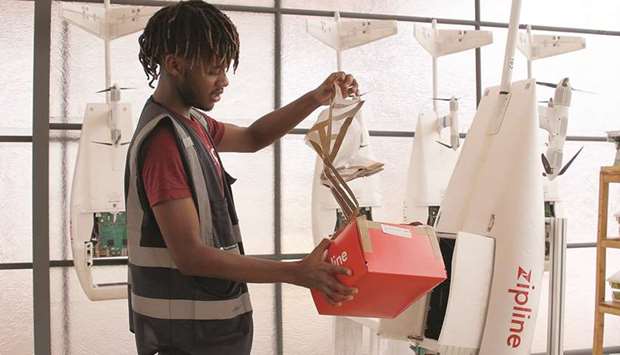Outside a small fenced-in property in the city of Muhanga in central Rwanda, a buzzing sound can be heard in the sky. It sounds like a swarm of mosquitoes, but in fact the noise is coming from a single object: a white drone.
The device circles above a runway, then moves itself into the correct position before falling down into a net that has been set up to catch it.
The drone has just returned from making a delivery of life-saving blood to a remote medical clinic. Within seconds, employees from American company Zipline begin to dismantle it.
A few minutes later, another drone is launched into the sky and begins the journey to another remote health centre, travelling at a speed of up to 100 kilometres per hour.
Zipline’s operations here are not just about making live-saving deliveries of blood within Rwanda. The Californian company is testing its business model here, and is also planning to launch in the US and other countries across the globe.
It is also hoping to start transporting medicines and vaccines in Rwanda in the near future, and hopes to eventually offer these services in other countries too.
Rwanda is an ideal testing ground for the drone deliveries because its aviation regulations are lenient, explains one of Zipline’s operational managers, Israel Bimpe.
“The government is very open regarding the regulatory aspects,“ he tells dpa.
Because the East African nation wants to attract innovation to stimulate economic growth, it allows drones to be flown long distances with just a simple license. Even highly automated drones can be used without special permits in the country.
“We want to specifically create the infrastructure and political framework for the introduction of new technology to improve people’s lives,” says information technology and communications minister Jean de Dieu Rurangirwa.
In comparison, drone operators in western nations typically need to meet a multitude of requirements, especially when flying drones commercially. Operators usually require a flight licence, and there are various regulations around drones of different weights.
That’s why developers and entrepreneurs who want to push new projects are looking to Africa, where drones are being used in sectors including tourism, health, animal welfare, security, climate change and agriculture.
Moroccan company Atlan Space, for example, has developed artificial intelligence software that allows drones to detect environmental crimes such as illegal fishing and oil spills in West African waters and report them to authorities in real time.
As soon as a drone discovers unlawful activities, it sends a ship’s location and identification number to the authorities via satellite, according to Atlan Space chief executive Badr Idrissi.
In South Africa, Zimbabwe, Botswana and Malawi, similarly programmed drones help to track poachers as part of a programme called Air Shepherd. Equipped with infrared cameras, the drones detect the movement of people inside wildlife reserves at night and alert security forces.
“Our statistics show that poaching incidents decrease significantly when our drones are in the area,” says Air Shepherd director Otto Werdmuller Von Elgg.
Also in Malawi, drones are used to send blood samples for HIV testing from remote areas to a laboratory for diagnosis.
The practice has significantly reduced waiting times for important test results in the southern African country.
Further east, Sudan, a nation hit by decades of drought and famine, is also using drones.
Local company Massive Dynamics has built drones that strategically drop the seeds of acacia trees in areas threatened by desertification.
At the same time, the drones can diagnose the health of a wide range of agricultural plants, helping farmers, researchers and aid organisations to reduce crop damage.
In Nigeria, researchers have used drones to map archaeological sites in the ancient city of Ife, the cradle of West Africa’s Yoruba civilisation between the 10th and 12th centuries.
“With the help of aerial photography, we decide where to dig and which areas to focus on,” says Adisa Ogunfolakan, director of Nigeria’s Natural History Museum.
Drone footage has helped the researchers to discover previously unseen city walls, abandoned settlements, clay huts and ceremonial pits.
The Zipline site in Rwanda is a good example of how drone technology can simplify work and save money. When a patient at a rural clinic requires an urgent blood transfusion, a health worker can place an order via a simple and quick text message.
Within minutes, the drone is packed. Instead of many hours or even days, it takes only about 30 minutes before the life-saving goods are dropped by parachute.
Zipline sends an average of 30 drones per day across the country.
“If you want to save lives, every second counts. Drones are the solution for us,” says Rwandan health minister Diane Gashumba. – DPA

DEMONSTRATION: An employee of the US company Zipline demonstrates how a blood sample is prepared for delivery via drone.
